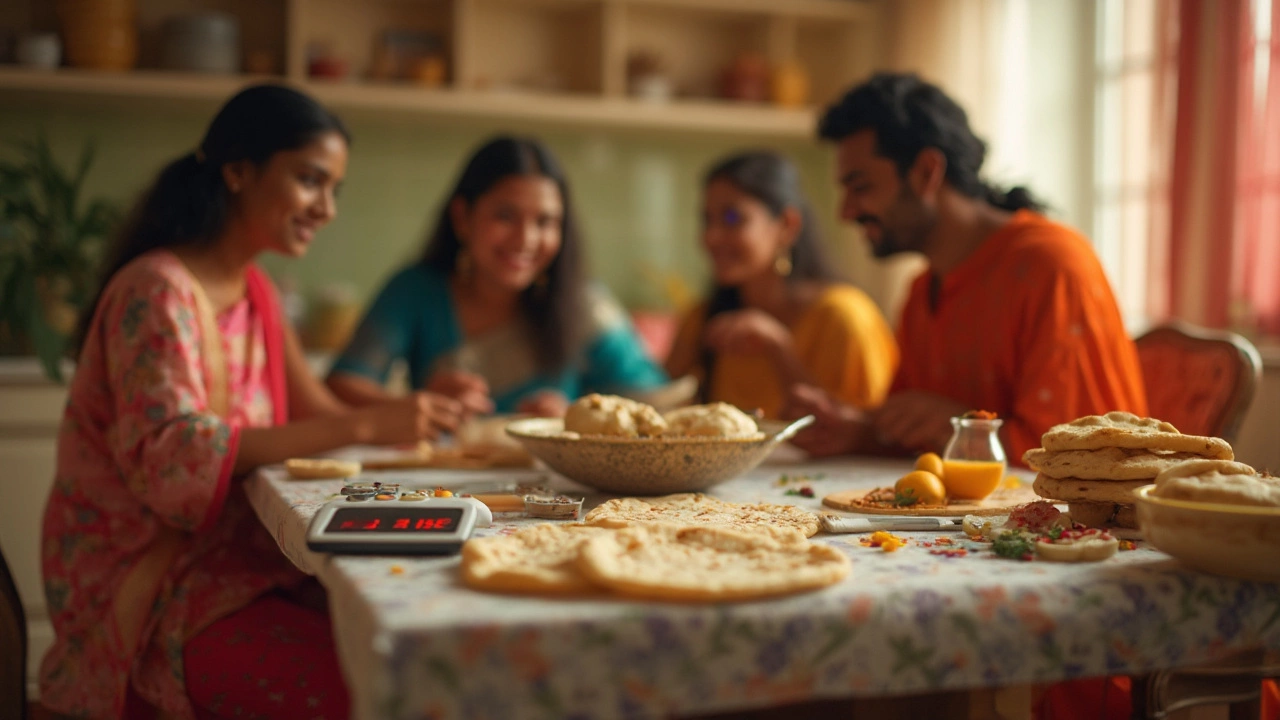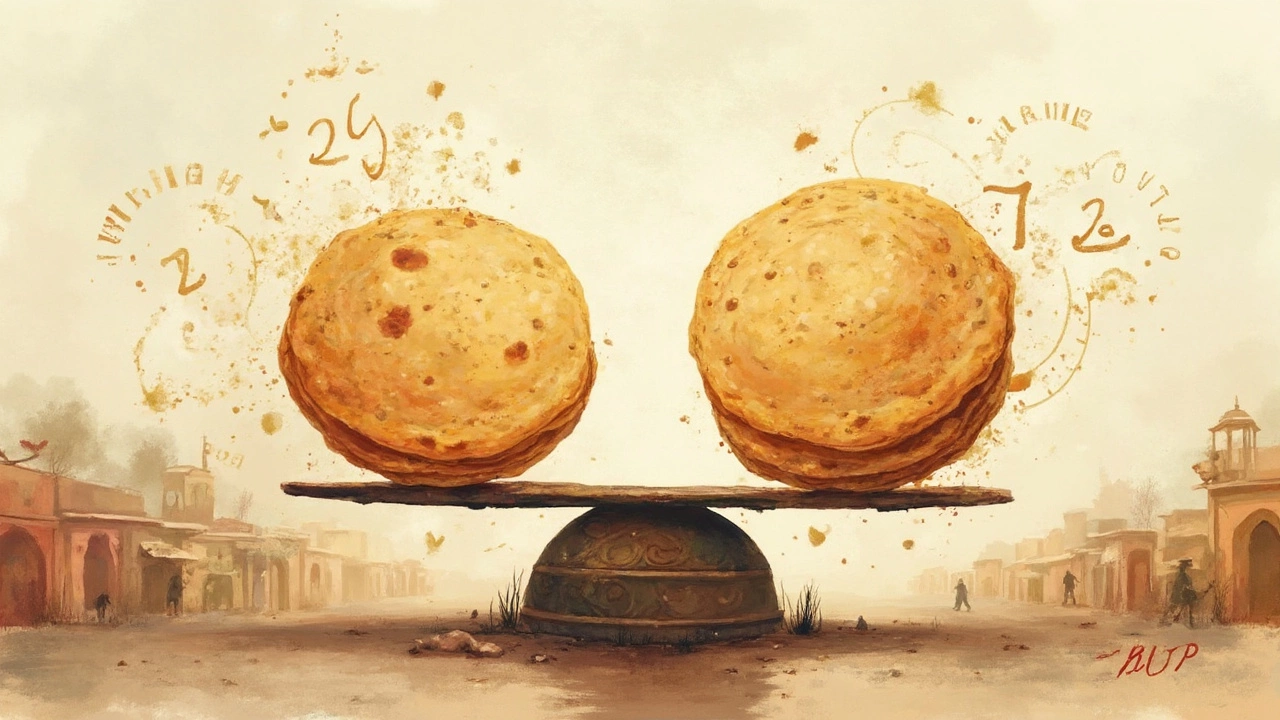Chapati and Your Diet: How Many Should You Eat Every Day?
 Feb, 26 2025
Feb, 26 2025
Ever wondered just how many chapatis you should include in your daily diet? Well, you're not alone! With chapatis being a staple in countless Indian homes, hitting the right number is key to a balanced diet.
Let's kick things off with the basics. The calories in one roti generally hover around 70-80. This depends on its size and thickness, so keeping that in mind is vital when planning meals. It’s easy to convert roti count into calorie count with a simple calculation.
Next up is understanding your calorie needs. This is where a calorie calculator comes in handy. Based on your Body Mass Index (BMI), age, activity level, and health goals, a calorie calculator can give you a daily caloric intake suggestion. Plug in your stats, and you’ll get a clear target to aim for.
Now, while our focus is on nutrition, it’s also useful to touch on the legal stuff. In India, regulations on food packaging demand details on nutrition labels. This means you can often find standardized information about calories in packaged rotis for your ease. Handy, right?
So, what’s the takeaway? Keep the roti count in line with your calorie needs, and remember that this varies from person to person. Adjust based on your activity and health targets, and you'll find the sweet spot for chapatis in your daily diet.
- Understanding Calories in One Roti
- Using a Calorie Calculator for Your Diet
- Legal Aspects of Nutrition Labeling in India
- How to Balance Chapatis in Your Daily Diet
Understanding Calories in One Roti
Let's break it down: the calories in one roti usually range between 70-80 calories. This might vary based on factors like size, thickness, and the type of flour used. For instance, a standard size roti made with whole wheat flour is about 70 calories, which is a standard in many Indian kitchens.
Now, why does knowing this matter? If you're counting calories or managing your bmi, keeping track of these numbers can make a difference in hitting your nutrition goals. The calculation is relatively simple. Multiply the number of chapatis with the average calorie count to get an estimate of your caloric intake from chapatis alone.
Ever wondered about the difference when using different types of flour? Here's a quick look:
| Type of Roti | Average Calories |
|---|---|
| Whole Wheat Roti | 70-80 |
| Bajra Roti | 97 |
| Jowar Roti | 100 |
What about the legal side of it? In India, food safety regulations ensure transparency in nutrition labeling, even for packaged rotis. This means you can find the caloric content right on the pack, making life a tad easier when you're at the grocery store.
Here's how you can manage your roti intake effectively:
- Start with knowing your BMR using a calorie calculator.
- Identify how much of that should come from carbohydrates, including rotis.
- Plan your meals around this data to suit your personal needs and goals.
This info can help you eat wisely, especially when balancing other components of your diet. Get excited about making an informed choice rather than starving yourself in confusion!
Using a Calorie Calculator for Your Diet
Trying to fit chapatis into your daily diet without blowing your calorie budget? A calorie calculator could be your new best friend.
Step-by-Step Guide to Using a Calorie Calculator
Getting started is super simple. Follow these steps:
- Gather Your Info: Before anything, have your weight, height, age, and gender ready. You need these to figure out your Body Mass Index (BMI).
- Assess Your Activity Level: Are you mostly sedentary or running marathons? Choose from categories like low, moderate, or high activity as this affects your calorie needs.
- Enter Your Details: Plug this data into any online calorie calculator—there are plenty just a quick search away.
- Calculate: Hit that calculate button to get your daily calorie needs. This is your ballpark figure for maintaining your current weight.
- Plan Your Meals: Now use this number to plan meals, adjusting your chapatis consumption accordingly to stay on track.
Legal Aspects in India
In India, nutritional information isn’t just a courtesy; it’s required. Thanks to food safety laws, most pre-packaged foods give you a detailed breakdown of what's inside, which includes calorie counts. This extends to some popular brands of packaged rotis too.
Local Considerations
Now, thinking locally, vitamin deficiencies like iron are common in India and have tweaked dietary needs. When adapting diet plans, considering local nutritional gaps can help in balancing chapati intake with other nutrients.
Importance of BMI
Knowing your BMI isn’t just a number—it's crucial in determining if your caloric intake aligns with your body's needs. Keeping tabs on this ensures your diet stays balanced and healthy.
Incorporating a calorie calculator into your diet planning isn't just about cutting calories, but about smart, informed eating. With these simple steps, managing your chapati intake becomes a breeze!

Legal Aspects of Nutrition Labeling in India
Nutrition labeling is vital for understanding what's in your calories in one roti and how it fits into your daily diet. In India, the Food Safety and Standards Authority of India (FSSAI) governs how food items are labeled. Their guidelines ensure you know what's in your food—making it easier for you to make healthy choices.
Understanding FSSAI Labeling Rules
The FSSAI requires packaged foods, including rotis, to have a detailed label. This includes a breakdown of calories, which helps you use a calorie calculator more accurately. Knowing the calories in one roti allows you to adjust the number of Chapatis you should eat in a day based on your diet requirements.
Here's what you can typically find on a nutrition label:
- Energy value in kilojoules (kJ) and kilocalories (kcal)
- Amount of protein, carbohydrates, and fats
- Information on added sugars and fiber
- Any additional vitamins and minerals
# Nutrition labeling is essential to help consumers make informed choices, said Dr. Harsh Vardhan, former Minister of Health and Family Welfare, India.
Importance for Consumers
Having access to this information is crucial. It helps you keep tabs on your daily limit, which is especially important if you're tracking your BMI or following a specific diet plan. Armed with this knowledge, you're not left guessing and can personalize your intake.
Practical Tips for Checking Labels
- Compare Labels: Always check across brands. Some brands pack more energy per serving!
- Look for Details: Choose products that list comprehensive nutritional values.
- Verify Claims: "Whole grain" or "multigrain" doesn’t always mean healthy without the numbers backing it up.
To sum up, the right nutrition labels, thanks to FSSAI, empower you to keep your diet in check. Making judicious use of this information aids in planning how many chapatis you should eat in a day based on your unique caloric needs.
How to Balance Chapatis in Your Daily Diet
Balancing chapatis in your diet is crucial to maintaining overall health, especially if your meal revolves around them. Here's how you can manage your chapati intake effectively:
1. Calculate Your Calorie Needs
Start with a basic step: figure out your daily caloric requirements. Using a calorie calculator can simplify this process. By imputing your height, weight, and activity level, you can determine an estimation of how many calories you need each day.
2. Portion Control
Keeping your portions in check is extremely important. If you're aiming for weight loss or management, consider limiting your chapati intake while increasing the portion of vegetables and proteins on your plate. A balanced diet involves more than just carbs.
- For a sedentary lifestyle: 2-3 chapatis per meal.
- Moderately active: 3-4 chapatis per meal.
- Physically active: 4-5 chapatis per meal.
3. Nutrient Timing
The time of day can affect how your body processes food. It's generally recommended to have the majority of your calories in one roti intake earlier in the day when your metabolism is faster.
4. Local Ingredients and Variations
In parts of India, like Maharashtra, multigrain rotis have become popular for their added fiber and nourishment. Incorporating local grains like jowar or bajra can also be beneficial and provide variety. This enables you to enjoy chapatis without missing out on nutrition.
5. Legal Aspects in India
While labeling laws often apply to packaged food, being informed can aid your decisions. Knowing what's in your food through nutrition labels can help you track what you're consuming, especially if you purchase ready-made chapatis.
6. Monitor Results
A crucial component of any diet plan is tracking progress. Check your Body Mass Index (BMI) regularly to ensure you’re heading in the right direction. You can do this monthly as fluctuations occur because of varied factors.
In summary, balancing your chapati intake requires a combination of understanding your calorie needs, adjusting portions based on activity levels, incorporating local ingredients judiciously, and staying informed about dietary laws and labels.
| Activity Level | Recommended Chapatis per Meal |
|---|---|
| Sedentary | 2-3 |
| Moderately active | 3-4 |
| Physically active | 4-5 |